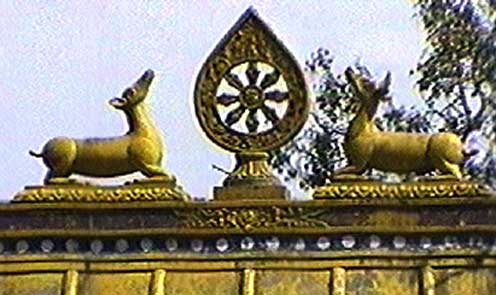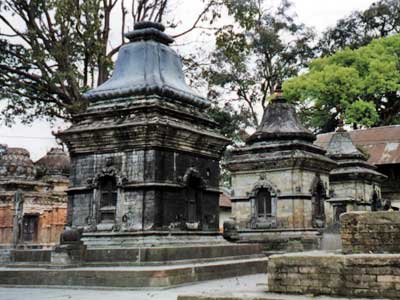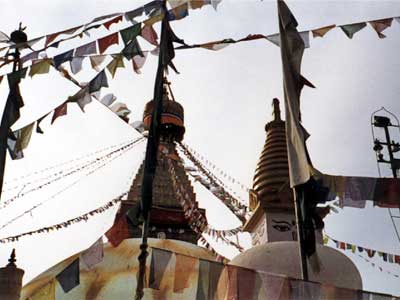KATHMANDU (Day 19)
At 6 am, we went up the roof to watch the sunrise. The colors were nice but the mountain were still obscured by mist.

We checked out and headed down to the bus station. We thought we were supposed to buy a ticket on the bus (like usual) but apparently there was some ticket stand in one of the small run-down buildings near by. But no one, not even the locals, seemed to know what to do.
Eventually we were on a bus back to Bhaktahpur. As with most of the busses, there is always one driver and another man who sells tickets and signals the driver when to go or stop. This is most often done by a series of knocking and banging on the bus doors or shrill whistling. While very cultural and charming at first, it can become quite obnoxious after a while. Not to mention, the guy whistled by putting his fingers in his mouth, which were completely black from handling all the money.
Back in town, we flashed our city passes at the front gate, and returned to the hotel to pick up the rest of our luggage. We joined forces with a middle-aged Swedish couple and split the cost of a taxi to Kathmandu. Our plan was to wander about and find a hotel, but the Swedes had a been given a recommendation. So we tagged along to check it out as well. Unfortunately it had an expensive looking lobby and even a door boy. We were all shocked by the prices listed... but this was a country of haggling, so it all worked out.
When we were back in the lobby signing in, we overheard a woman being told that she absolutely had to confirm her airline tickets. After she had left, we walked over and learned we positively NEEDED a stamp on our plane tickets or we couldn't fly. Oh, and you can't just call, you have to go in person to a Royal Nepal Airlines office.
And so, we headed out in search of the office. We had something of a map but it still took an extremely long time to to find it. Once there, we waited in the long, rather confusing, crowded lines. Eventually we were helped by a woman who told us our seats had been cancelled. What?! And so she went away, came back, went away again, and after about 10 minutes, we were confirmed... and had our tickets stamped.
Now that our morning had been wasted, we just decided to rent an auto tuktuk for the day and have him show us the most important sites.
We bounced our way through the traffic and side alleys and eventually arrived at Swayambhunath, a huge buddhist stupa (temple) on a hill. We passed under the main gate with its two deer statues overhead and began to climb the 365 steps to the top. But these weren't just any steps. Not only were they lined with vendors, the uneven steps were slanted downwards so it always felt like we were about to fall backwards at any moment. Plenty of monkeys, dogs and playing children also added to the obstacle course.

The Dharma wheel is a symbol of the Buddha's first teachings in the Deer Park in Sarnath, India. Dharma essentially means 'the right way of living'. The eight spokes point inward, indicating that suffering is an internal rather than an external condition. They represent right understanding, aspiration, speech, conduct, vocation, effort, alertness and concentration. The deer are looking up at the wheel and listening to the teachings of the Buddha.
At the top there are several temples and even a restaurant. At each of the four corners was a white temple with a statue of the Buddha. A sign explained that we were allowed to photograph the statue, but we were not allowed to have our picture taken WITH it.


The eyes of the Buddha (eyes of wisdom and compassion, representing a person awakening) look in all four directions. The 13 rings above the eyes symbolize the steps of the ladder leading to nirvana. The large white dome represents the four elements of earth, fire, wind and water. Prayer flags, made of partially transparent material, hung from the top.
We climbed back down, hopped into the tuktuk and proceeded to drive over some of the worst dirt paths imaginable. Our stomachs felt each thud as the small vehicle drove right through the enormous potholes. There was also nothing to hold on to inside, just hard metal on all sides. We literally bounced off the seat.
We arrived at Pashupatinath, the most sacred Hindu temple in Nepal. The temple is at least 1,500 years old and dedicated to Shiva (or Pashupati). When reached an entrance gate but were told it was only for Hindus, not tourists. We turned back, wandered about a bit and eventually found our correct gate. We crossed over a bridge toward the center of the complex. The Bagmati River was almost completely dry and probably contained more trash than water.
On one side of the river were the burning ghats, where cremations took place. On top of several short pillars were small piles of simmering wood. The fires were rather small and there were no distinctive body parts visible. A man was covering one pile with long clumps of wet straw, causing plenty of smoke. While this was busy smoldering, he washed off another pillar with a large bucket of water. On the stairs leading down to the river, several colorfully wrapped bodies lay waiting to be burned.

Bodies in flame and smoke
At the top of the complex were rows and rows of the small square temples... as well as tons of monkeys and dogs. We began to understand how Kathmandu had acquired the nickname of Dogmandu. Officially "Kat - mandu" means "wood house".

We then bounced our way through the narrow bumpy little back alleys to Boudhanath, the largest buddhist stupa in Nepal. Boudhanath is not built on a hill but is rather comprised of a series of huge steps which represent the steps to nirvana.

Many prayer wheels lined the base, and people of all sizes, ages and gender were busy turning them... some with more care (like the monks) than others who just dragged their hand along them as they walked briskly by.
Prayer wheels are devices for spreading spiritual blessings and well being. Rolls of thin paper, printed with many copies of the mantra (or prayer) of 'Om Mani Padme Hum' are wound inside a protective container. By spinning the container in a clockwise direction, a person can invoke powerful blessings of compassion. The more spins, the more mantras sent, the better.
In the mantra, each syllable corresponds to one of the six realms of existence and represents the purification that realm:
Om - purifies bliss and pride (realm of the gods)
Ma - purifies jealousy and need for entertainment (realm of the lower or demigods)
Ni - purifies passion and desire (human realm)
Pad - purifies ignorance and prejudice (animal realm)
Me - purifies poverty and possessiveness (realm of the hungry ghosts)
Hum - purifies aggression and hatred (purgatory realm)

The Temple of 1000 Buddhas contained one giant, constantly-turning prayer wheel that filled the entire small room. A small rod attached to the top of the wheel was swung around and around, hitting a small bell on the wall, which caused a very rhythmic chime. The temple got its name from the many identical pictures of Buddha that covered its walls.

Different hand gestures convey specific Buddhist teachings. Postures (seated, standing or reclining) also have symbolic meaning. The long earlobes may come from the tradition of Indian royalty wearing heavy earrings. Since the Buddha was originally a royal prince (Prince Siddhartha Gautama), he most likely wore such adornment. In both Chinese and Buddhist cultures, long earlobes are equated with longevity.

At the very top was a set of painted eyes. Literally thousands of prayer flags hung from many lines around and to the temple top.

The dot is likened to a third (or cosmic) eye which emanates the light of wisdom, signifying the Buddha’s supreme insight.
The ride back was amazingly even worse. Not only did we bump a cyclist but we also went down a one-way street... the wrong way. We paid the man and were about to leave when he started making a big fuss because we had paid him too MUCH. We happily told him to keep the change and were both happily stunned by his honesty.
While the number of temples and shopping opportunities were endless, the bad air was taking its toll on me and I decided to spend the rest of the evening recovering in the hotel. The dust and air pollution was truly incredible.

Endless shopping possibilities
return • continue

